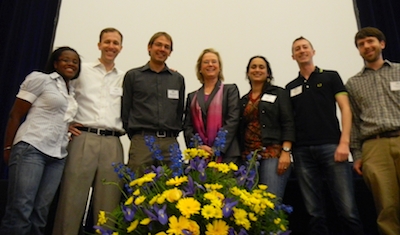Read the bill. That was the first policy lesson that Linda Adams, Secretary of the California Environmental Protection Agency, brought to the newly minted Ph.D.’s at the Graduate Research Symposium of UC Berkeley’s Department of Environmental Science, Policy, and Management (ESPM) earlier this month, where she delivered the keynote address.
The bill Adams was referring to was AB 32, the landmark Global Warming Solutions Act of 2006, on which she was the lead negotiator. She told a harrowing tale of the legislative pipeline.
“When Governor Schwarzenegger appointed me in 2006… I was just vaguely aware of AB 32, which was actually very close to his desk,” Adams said. “Being a good former legislative staffer, the first thing I did was read the bill. And much to my horror, what the governor wanted — a market-based approach to reducing emissions — was not only not in the bill but actually prohibited.”
Adams’ discovery resulted in a fight for a comprehensive approach to reducing emissions that California businesses would support, including a cap-and-trade program and complementary measures such as low-emissions vehicles, renewable energy, and increased energy efficiency. The bill that ultimately passed was the nation’s first major climate-change legislation, and was what the California Air Resources Board refers to as the “first-in-the-world comprehensive program of regulatory and market mechanisms to achieve real, quantifiable, cost-effective reductions of greenhouse gases.”
Her achievements resonated with the audience; environment and climate-change related work is the one common thread among the diverse lines of scientific inquiry pursued at ESPM. Research presented by the graduating Ph.D. students included modeling the impact of climate change on a Bay Area redwood forest, studying changes bird populations in the Sierrra Nevada, analyzing the politics of chemical monitoring, and studying the growth of eco-labels and sustainability ratings—so-called “green” products and services.
Putting the science in government
This broad spectrum of inquiry meshed well with the key theme of Adam’s talk: Science matters.
“Every policy regulation we make here at Cal EPA is based on science,” Adams said. “We rely on our experts when developing policies and… we depend on the accuracy, the timeliness, the relevance, and the needed answers they can supply,” she said.
To the delight of a room filled with fresh job-seeking Ph.D.'s, Adams said that Cal EPA employs hundreds of scientists in various areas of expertise.
What do they do? As an example, Adams cited an agency-wide investigation into a spike in birth defects in the small town of Kettleman City.
“It involved scientists from each department looking into potential links to water, soil, air, and/or pesticide pollution,” she said. “The Department of Pesticide Regulation provided models of pesticide activity in the formative months of pregnancy; the Air Resources Board (ARB) monitored the air in the area; the Water Board tested the tap water and canal for arsenic and other pollutants; and the Department of Toxic Substances Control tested the soil for contamination.
The role of forests
The new world of AB 32 will generate the need for new areas of scientific expertise at Cal EPA. In additional to a full spectrum of chemical and environmental monitoring, there will be growing demand for forestry and reforestation knowledge.

That translates to forests. Of the four offset protocols adopted by the ARB, two were forestry protocols: one for urban forestry and one for U.S. forest reforestation and forest management projects.
“We already have over 100 forestation and forest management projects submitted for approval as offsets all over the United States,” Adams said. Cal EPA is also exploring the international market for carbon reduction, through cutting-edge pilot forest redevelopment programs in Chiapas, Mexico, and Acre, Brazil.
Calling to account
As the state begins to implement AB 32 and build a national and international accounting framework, Adams said science will be especially important.
“We need to ensure that all reductions achieved are real, permanent, quantifiable, verifiable, and enforceable, and we rely on the science to provide reduction and emission calculation methods, to identify procedures for project monitoring, reporting parameters, and verification,” she said. “We need the scientific backing to reinforce the policy outcomes we seek, and the research to determine if those sought-after outcomes are possible.… It’s all one continuous cycle.”
In addition to the keynote address, the May 6 Berkeley symposium, dubbed “Gradfest,” also had 15 research presentations, two poster sessions, and a career panel and to help usher ESPM graduates into the various professional arenas of academia, government, nonprofit, and the private sector.

Attached Files: